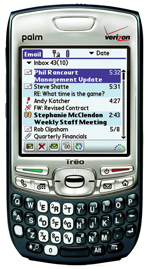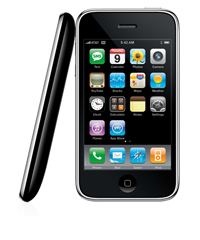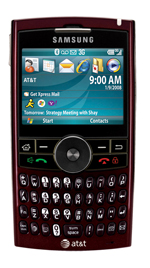Learning 3G-Speak

Palm Treo.
Photo courtesy Verizon
Will your cellular phone or other wireless device untether you and become the main platform from which you access the Internet? Could be, and in the very near future. New devices, wireless standards and availability of anytime-anywhere access are becoming commonplace.
Apple’s new 3G iPhone has generated a great deal of excitement and raised awareness about high-speed wireless data access through cell phones and other mobile devices. Lawyers are increasingly using BlackBerrys, Treos and wireless modems for mobile Internet access, yet there are many questions. Yes, there is potentially faster access, but the wireless world—and its ever-changing array of standards—is a confusing place populated by acronyms, vendor-specific services and availability questions.
I want to give you a primer to help you navigate through this confusing world. Note that wireless is a worldwide phenomenon, but this column will largely focus on the U.S., with some notes about global issues.
Let’s start with the G’s.
In wireless, G stands for generation. 3G means third generation; 2G is second generation (and so last year), and 4G is, of course, fourth generation. We are well along in the process of moving from 2G to 3G, with some aspects of 4G just around the corner. The 2G to 3G transition has been a lengthy one and you’ll often see references to 2.5G and even 2.75G as transitional phases, and as debates arise over which generation a technology should be assigned.
The key lesson is that the different generations co-exist, and your cell phone might well be moving seamlessly among the technologies in different generations. It also means that in some service areas, you might be in a 2G environment because the 3G platform is not available.
HUH?
In the 2G world, the vast majority of wireless phones fall into two categories: GSM and CDMA. Perhaps 80-85 percent of the cell phones in the world use the GSM standard. GSM stands for Global System for Mobile communications. Phones with GSM services use tiny SIM cards that contain user identity information as well as names and phone numbers from the user’s address book. It’s easy to move between carriers by simply placing the card into a new phone.
For data, the GSM world uses GPRS and a standard known as EDGE. GPRS stands for General Packet Radio Services. GPRS is the standard used in GSM to deliver dial-up modem data speeds. EDGE is the acronym for Enhanced Data rates for GSM Evolution. Some refer to this as a 2.75G technology. Early iPhone adopters were disappointed with the iPhone’s availability only on AT&T because of the lackluster speed of EDGE, about three times that of a dial-up modem. A BlackBerry Curve, for instance, on AT&T would use EDGE.
The other 15-20 percent of wireless phones—almost all in the United States—use the CDMA standard. CDMA means Code Division Multiple Access. Sprint and Verizon use this technology. In the U.S., the terms CDMAOne and IS-95 are used in connection with this standard.
The CDMA world, which is largely moving to a 3G standard known as EV-DO, uses a 2G data standard known as 1xRTT—One times Radio Transmission Technology—which increases network voice capacity and offers much faster data speeds. The CDMA and GSM standards are incompatible and use the available bandwidth in different ways.
These technologies are transitional as 3G is a standard designed to handle both voice and data simultaneously. While 3G will make our lives as users much easier, the acronyms actually get more confusing.
In the 3G era, we see more movement toward the GSM world. In fact, some analysts suggest the recent Verizon purchase of Alltel might well leave Sprint as the only major U.S. carrier still in the CDMA world. The key development for 3G is high-speed (think of DSL levels of speed) wireless data access.

iPhone 3G.
Photo courtesy Apple
AGAIN—HUH?
Here’s the confusing part: 3G systems in both the GSM and CDMA world have names that include the letters CDMA, even though they use different technologies. The good news is that there is some optimism the technologies will be able to talk to each other, giving us the potential of being able to use the same cell phones or mobile devices no matter where we are.
In the GSM world, the standard is known as UMTS, which stands for Universal Mobile Telecommunications System, also known as W-CDMA, with the W signifying wideband. Thankfully, people are starting to call this 3GSM. A Samsung Blackjack II on AT&T would use UMTS.
In the CDMA world, the 3G standard is CDMA2000. The data standard for CDMA2000 is EV-DO (EVolution Data Only). EV-DO is a high-speed wireless data standard, now in its second revision. Speeds like 4.9 megabits per second are possible. Wireless cards like the Verizon Wireless Aircard 595 and V740 ExpressCard have become popular choices for travelers, giving them high-speed Internet access on their laptop computers from almost anywhere. Also see the new Palm Centro.

Palm Centro.
Photo courtesy Verizon
The data standard for W-CDMA/UMTS is HSPA, which stands for High Speed Packet Access. This is a high-speed data access technology used in connection with UMTS and the one chosen by AT&T and Apple for the iPhone.
We’re almost done, so hang on if you are feeling dizzy.
Let’s take a quick look at 4G. This fourth-generation technology expects a convergence with the Internet protocol standards and speeds equivalent to wired technologies with high levels of security and Internet data and voice access from nearly anywhere. The name being bandied about for 4G is LTE (Long-Term Evolution) and technologies like WiMax and iBurst are considered examples of pre-4G technologies.
It’s also important to mention one more form of wireless Internet access.
That’s Wi-Fi, the short-distance networking technology we use in home networking and for wireless access at hotels, restaurants and the like. The main issue with Wi-Fi is that you must be very close (within 100 feet or so) of a Wi-Fi access point. The speed is great, but the trade-off is limited access and a limited number of public access points.
The interesting development is that a mobile device like an iPhone can move invisibly between 2G and 3G voice and data systems and even access the Internet through Wi-Fi. It’s a new era for widespread and almost-always-available Internet access.

Samsung Blackjack II.
Photo courtesy Samsung
WHAT WE’VE LEARNED
What are the key lessons to take away from all this?
1.These technologies are carrier-driven. You’ll want to understand enough to know what your carrier provides.
2.Capability is very different from availability. Your new 3G iPhone will only be able to give you 3G levels of access in areas where 3G technologies are available. That’s not necessarily a bad thing, but it’s something that you’ll want to know ahead of time.
3.The convergence of voice and data is gradually happening and we are getting much closer to a world where a phone, especially a “smartphone” or other mobile device, can be a platform for both Internet and computing.
4.You’ll need robust data plans, so expect your cell phone bills to increase.
With a little effort, you can speak knowledgeably about the mobile phone and data world, and navigate your way into this next generation of mobile access.
Dennis Kennedy, a St. Louis-based computer lawyer and legal technology consultant, is a regular contributor to the ABA Journal. DennisKennedy.com, his website, is the home of his blog. Contact him at [email protected].



